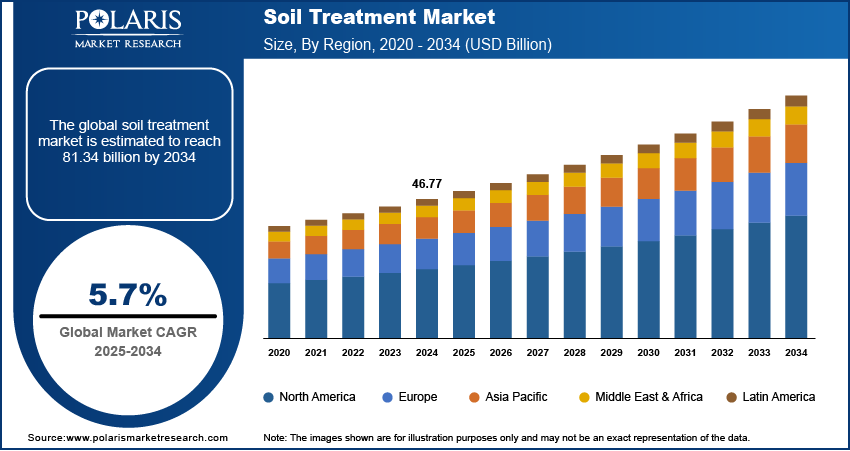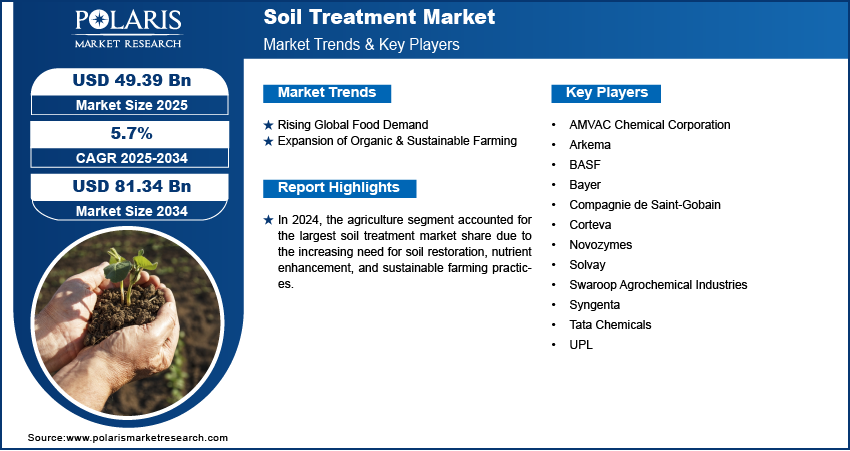
Soil Treatment Market Share, Size, Trends, Industry Analysis Report, By Type (Organic Amendments, pH adjusters, Soil Protection); By Technology; By End User; By Region; Segment Forecast, 2023-2032
- Published Date:Jun-2023
- Pages: 114
- Format: PDF
- Report ID: PM3388
- Base Year: 2022
- Historical Data: 2019-2021
Report Outlook
The global soil treatment market was valued at USD 41.96 billion in 2022 and is expected to grow at a CAGR of 5.71% during the forecast period. Rapid urbanization and industrialization are leading to an increase in contaminated soil. Soil treatments are being used for the remediation of contaminated soil at construction sites and industrial areas. According to estimates, 55% of all pollutants in the EU are organic. Mineral oil contamination has impacted roughly 24% of European soils. The growing problem of organic pollutants in Europe has led to an increased demand for soil treatment solutions, which is fueling the growth of the soil treatment market. Organic pollutants are chemicals that are derived from natural sources, such as plants and animals, but are often produced or used by humans in industrial processes, agriculture, or waste disposal.

To Understand More About this Research: Request a Free Sample Report
Industry Dynamics
Growth Drivers
The world's population is growing, and this is driving the demand for food and agricultural products. Soil treatments market are being used to increase crop yields to meet the demand for food. There are increasing regulations regarding the use of chemical fertilizers and pesticides. This is driving the adoption of eco-friendly soil treatments, such as organic amendments and biological treatments, to reduce environmental pollution. Achieving the Sustainable Development Goals of the United Nations requires the restoration of contaminated land in order to restore ecosystem services and biodiversity (UN-SDGs). Which will further drive the growth of the market in coming years.
Soil treatment market is seeing technological advancements, including the development of physiochemical treatments and thermal treatments, which are increasing the efficiency and effectiveness of soil treatments. There is a growing awareness of the importance of soil health in agriculture and construction industries. Soil treatments are being used to improve soil quality, increase crop yields, and reduce soil erosion. There is a growing demand for organic food products, and soil treatments are being used to promote sustainable agriculture practices, such as the use of organic amendments and biological treatments.

For Specific Research Requirements, Speak to Research Analyst
Report Segmentation
The market is primarily segmented based on type, technology, end user, and region.
|
By Type |
By technology |
By End User |
By Region |
|
|
|
|
To Understand the Scope of this Report: Speak to Analyst
Organic Amendments Segment is Expected to Witness Fastest Growth During Forecast Period
Organic amendments segment is one of the key drivers of growth in the soil treatment market. They are natural substances that are added to soil to improve its fertility and productivity. These amendments include materials such as compost, manure, and other organic matter. One of the main reasons why organic amendments are driving the growth of the soil treatment market is that they are a more sustainable and environmentally-friendly option compared to synthetic fertilizers and other chemical treatments. Consumers are becoming more aware of the negative impact that synthetic chemicals can have on the environment and are seeking out more natural alternatives.
Biological Treatment Accounted for the Largest Market Share in 2022
Biological treatment segment registered with the larger market share in 2022, this trend is projected to continue in the study period. These are environmentally friendly as they use natural processes to remediate contaminated soil. They do not involve the use of harsh chemicals or heavy machinery, which can have negative impacts on the environment. These treatments are generally considered to be more cost-effective than other treatment methods, such as thermal or physiochemical treatments. They require less equipment and maintenance, and can be applied in situ, reducing the need for excavation and transportation of contaminated soil.
Agriculture Segment is Expected to Hold the Significant Revenue Share in 2022
Agriculture segment is projected to witness a larger revenue share in the study period as it is a major user of soil treatment products. Growing global population has led to an increased demand for food, which has put pressure on agricultural producers to increase crop yields. Soil treatment products are essential to achieving this goal, as they help to maintain soil health and fertility, which in turn increases crop productivity and yield.
The adoption of sustainable agricultural practices is driving demand for soil treatment products. Consumers are becoming increasingly aware of the impact that agricultural practices can have on the environment, and are seeking out products that are produced in a sustainable manner. Soil treatments such as organic amendments and bio-stimulants are a key component of sustainable agriculture, as they reduce reliance on synthetic fertilizers and pesticides and promote soil health and biodiversity.
Apac Projected to Witness Higher Growth Rate in the Study Period
APAC is projected to witness higher growth for the market in the study period. It has the world's largest population, and this is expected to continue growing in the coming years. As the population grows, the demand for food and agricultural products will also increase, driving the need for soil treatments to improve soil quality and crop yields. Region is experiencing rapid urbanization, which is leading to an increase in contaminated soil from construction and industrial activities. This is driving the demand for soil treatments for the remediation of contaminated soil.
The growing presence of organic and inorganic contaminants in soil in China has become a major environmental and public health concern in the Asia Pacific region. As a result, the demand for soil treatment solutions has been increasing, fueling the growth of the soil treatment market in the region. In China, a countrywide soil survey conducted from April 2005 to December 2013 found that a total of 16.1% of the soil samples were found to have inorganic or organic contaminants. Industrialization, urbanization, and agricultural practices are contributing to the growth of soil contamination in this region. As a result, there has been an increase in demand for soil treatment solutions which can help to remediate contaminated soil and make it safe for use again.
North America is Expected to Witness Larger Revenue Share in 2022
North America garnered with the largest revenue share throughout the study period. It has a long history of sustainable agriculture practices, and there is a growing trend towards adopting eco-friendly practices, including the use of soil treatments. This is driving the demand for soil treatment products and services in the region. North America has some of the most stringent environmental regulations in the world, particularly regarding the use of chemical fertilizers and pesticides. This is driving the adoption of eco-friendly soil treatments, such as organic amendments and biological treatments, which are seen as safer and more sustainable alternatives.
The presence of polluted soil fields in the United States has become a major environmental and public health concern, and as a result, the demand for soil treatment solutions has been increasing. This trend is fueling the growth of the soil treatment market in North America. Nearly, 10 Mn polluted soil fields are present across the globe, with 100,000, 80,000, & 50,000 sites in the U.S, the EU, & Australia, respectively. The sources of soil pollution in the United States include industrial activities, mining, oil and gas exploration, transportation, and urbanization.
Competitive Insight
Some of the major players operating in the global market include AMVAC Chemical, Arkema, BASF, Bayer, Compagnie de Saint-Gobain, Corteva, Novozymes, Solvay, Swaroop Agrochemical Industries, Syngenta, Tata Chemicals & UPL.
Recent Developments
- In November 2022, AMVAC, a leading global provider of agricultural technology solutions, expanded its line of biological Green Solutions products with the addition of BioWake dual-use seed lubricant.
- In January 2023, PUM has created a geotextile that can be customized to fit any style of parking lot in order to protect the environment from the micropollutants linked to runoff. AQUA'PUM filters hydrocarbons, defends the soil, and aids in environmentally friendly city development.
Soil Treatment Market Report Scope
|
Report Attributes |
Details |
|
Market size value in 2023 |
USD 43.78 billion |
|
Revenue forecast in 2032 |
USD 72.15 billion |
|
CAGR |
5.71% from 2023 - 2032 |
|
Base year |
2022 |
|
Historical data |
2019 - 2021 |
|
Forecast period |
2023 - 2032 |
|
Quantitative units |
Revenue in USD billion and CAGR from 2023 to 2032 |
|
Segments covered |
By Type, By Technology, By End User, By Region |
|
Regional scope |
North America, Europe, Asia Pacific, Latin America, Middle East & Africa |
|
Key companies |
AMVAC Chemical, Arkema, BASF, Bayer, Compagnie de Saint-Gobain, Corteva, Novozymes, Solvay, Swaroop Agrochemical Industries, Syngenta, Tata Chemicals & UPL. |
FAQ's
key companies in Soil Treatment Market are AMVAC Chemical, Arkema, BASF, Bayer, Compagnie de Saint-Gobain, Corteva, Novozymes.
The global soil treatment market expected to grow at a CAGR of 5.71% during the forecast period.
The Soil Treatment Market report covering key segments are type, technology, end user and region.
key driving factors in Soil Treatment Market are Ensuring Food Security.
The global soil treatment market size is expected to reach USD 72.15 billion by 2032.
